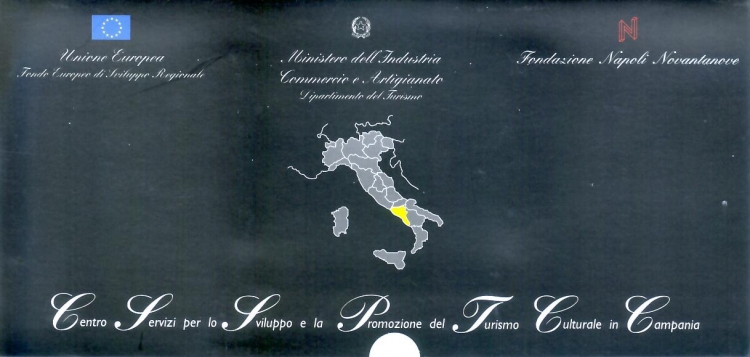
1997-1999
The Centre for the promotion and development of cultural tourism in Campania was set up by the Naples Ninety-nine Foundation Under The Multi-Regional Programme For The Development And Promotion Of Sustainable Tourism In Objective 1 Regions , which is carried by the Italian State Department Of Tourism, and co-funded by the European Community, European Regional Development Fund.
The Centre's activities seek to promote hitherto little-known or forgotten aspects of Campania's cultural heritage. The aim is to turn the region's extraordinary reservoir of art and culture into concrete development opportunities
The Centre is involved in a wide range of activities: it researches, catalogues and monitors the area's cultural heritage; it provides specialist place-marketing and promotion services, and assistance in organizing visits to the various sites; it designs themed or specially tailored itineraries of touristic and cultural interest for tour operators, tourist agencies, local authorities and other organized tourism initiatives; and it produces leaflets, brochures and other material on Campania's many places of interest.
The Centre can draw on its own vast multimedia archive, covering Campania's cultural and natural resources. To date, it contains over four thousand files and some seven hundred images. The archive has been put together over a two-year period, involving on-the-spot research in the various localities, and is being constantly expanded and up-dated.
Apart from Campania's most famous sites - such as the Phlegraean Fields, perhaps the world's richest archaeological site, and the Royal Palace of Caserta, one of the grandest architectural complexes in Italy - the Centre has sought to discover lesser-known localities throughout the area known in ancient times as Campania felix and its more remote regions.
One hundred and sixty-six localities have been researched and catalogued, and these have been grouped into the twenty different themed tours or itineraries described below, four each for the five different Campanian provinces. They include fine towns with impressive monuments and buildings; often well-preserved medieval settlements where the original urban layout can still be seen; age-old fortified villages, their picturesque labyrinth of narrow cobbled streets and alleyways, often only accessible on foot, spiralling up the lower slopes of the mountains or clinging to the cliffs below their castle; old farmsteads; tiny fishing villages and hilltop hamlets, oases of lush, uncontaminated nature buried in the luxuriant Mediterranean maquis.
For each locality, the main historical, artistic, architectural and natural sites have been identified and catalogued. Local craft traditions, agricultural, food and culinary customs, as well as the unique non-material cultural heritage of popular folklore and festivals, have also been researched and recorded.
The result is an unforgettable journey through an amazing variety of scenery, towns and landscapes, where the mingling of civilizations and cultures Ancient Greek, Lucanian, Basilean, Saracen and Norman - is still apparent. Each of these cultures has left its imprint on the land and its people. The unique blend of history, nature, artistic treasures and a long folk tradition make Campania one of the world's best-kept secrets.
All rights reserved: photographic archive, texts and translations.
ALL RIGHTS RESERVED, ARCCORDING TO INTERNATIONAL LAWS AND CONVENTIONS.
Nessun materiale può essere riprodotto senza autorizzazione.